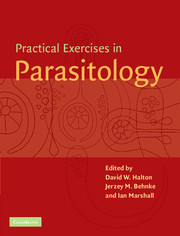Book contents
- Frontmatter
- Contents
- List of contributors
- Preface
- General advice
- 1 Observational Exercises on Parasites
- 2 Ecology
- 3 Physiology and Biochemistry
- 4 Pathology and Immunology
- 4.1 Encapsulation of foreign matter (not-self) by earthworms
- 4.2 Opsonisation of trypanosomes
- 4.3 Production and screening of monoclonal antibodies against Leishmania promastigotes
- 4.4 Pathological effects of Mesocestoides corti and Schistosoma mansoni
- 4.5 Quantification of lymphocyte populations in the spleen and thymus
- 4.6 Use of basic indirect ELISA for the detection of antibodies produced by experimental immunisation
- 4.7 SDS PAGE and Western blotting for the detection of antibodies produced by experimental immunisation
- 5 Chemotherapy
- 6 Molecular Parasitology
- 7 Behaviour
- Appendix 1 Reagent index
- Appendix 2 UK suppliers
- Appendix 3 US suppliers
- Index
4.4 - Pathological effects of Mesocestoides corti and Schistosoma mansoni
Published online by Cambridge University Press: 05 June 2012
- Frontmatter
- Contents
- List of contributors
- Preface
- General advice
- 1 Observational Exercises on Parasites
- 2 Ecology
- 3 Physiology and Biochemistry
- 4 Pathology and Immunology
- 4.1 Encapsulation of foreign matter (not-self) by earthworms
- 4.2 Opsonisation of trypanosomes
- 4.3 Production and screening of monoclonal antibodies against Leishmania promastigotes
- 4.4 Pathological effects of Mesocestoides corti and Schistosoma mansoni
- 4.5 Quantification of lymphocyte populations in the spleen and thymus
- 4.6 Use of basic indirect ELISA for the detection of antibodies produced by experimental immunisation
- 4.7 SDS PAGE and Western blotting for the detection of antibodies produced by experimental immunisation
- 5 Chemotherapy
- 6 Molecular Parasitology
- 7 Behaviour
- Appendix 1 Reagent index
- Appendix 2 UK suppliers
- Appendix 3 US suppliers
- Index
Summary
Aims and objectives
This exercise is designed to demonstrate:
Qualitative changes in body-organ systems occupied by parasites.
Quantitative changes in body-organ systems associated with infection.
Histological changes associated with infection, including the direct effects of parasites and the host response.
Introduction
Pathology is the study of the cause and effects of disease as seen in the changes in tissues and organs. The majority of infectious agents, including many parasites, cause some changes in the host that are reflected in alterations in the appearance and function of specific organs. Many parasites cause chronic infections in which pathological changes develop over a protracted period of time, during which the host's health may deteriorate gradually as a consequence of the accumulated damage to organ systems, but seldom sufficiently for the parasite itself to be directly responsible for death. Some of these changes may be sufficiently intense to affect the parasite's route of migration to its preferred site, thereby either protecting the host from further infection or resulting in the spread of the parasites to new sites. In this exercise, the pathological effects of two parasites, commonly maintained in laboratories for medical research, Mesocestoides corti and Schistosoma mansoni, will be assessed qualitatively and quantitatively. This will be achieved by close comparison of the organs and tissues of infected and uninfected animals, in order to identify changes associated with infection.
- Type
- Chapter
- Information
- Practical Exercises in Parasitology , pp. 267 - 276Publisher: Cambridge University PressPrint publication year: 2001

